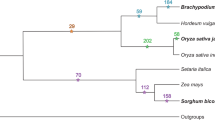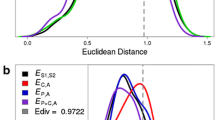Abstract
Duplicate genes are believed to be a major source of new gene functions over evolutionary time. In order to evaluate the evolutionary dynamics of rice duplicate genes, formed principally by paleoployploidization prior to the speciation of the Poaceae family, we have employed a public microarray dataset including 155 gene expression omnibus sample plates and bioinformatics tools. At least 57.4% of old ~70 million years ago (MYA) duplicate gene pairs exhibit divergences in expression over the given experimental set, whereas at least 50.9% of young ~7.7-MYA duplicate gene pairs were shown to be divergent. When grouping the rice duplicate genes according to functional categories, we noted a striking and significant enrichment of divergent duplicate metabolism-associated genes, as compared to that observed in non-divergent duplicate genes. While both non-synonymous substitution (Ka) and synonymous substitution (Ks) values between non- and divergent duplicate gene pairs evidenced significant differences, the Ka/Ks values between them exhibited no significant differences. Interestingly, the average numbers of conserved motifs of the duplicate gene pairs revealed a pattern of decline along with an increase in expression diversity, partially supporting the subfunctionalization model with degenerative complementation in regulatory motifs. Duplicate gene pairs with high local similarity (HLS) segments, which might be formed via conversion between rice paleologs, evidenced higher expression correlations than were observed in the gene pairs without the HLS segments; this probably resulted in an increased likelihood of gene conversion in promoters of the gene pairs harboring HLS segments. More than 60% of the rice gene families exhibited similar high expression diversity between members as compared to that of randomly selected gene pairs. These findings are likely reflective of the evolutionary dynamics of rice duplicate genes for gene retention.

Similar content being viewed by others
References
Adams KL, Wendel JF (2005) Polyploidy and genome evolution in plants. Curr Opin Plant Biol 8:135–141
Altschul SF, Gish W, Miller W, Myers EW, Lipman DJ (1990) Basic local alignment search tool. J Mol Biol 215:403–410
Barrett T, Troup DB, Wilhite SE, Ledoux P, Rudnev D, Evangelista C, Kim IF, Soboleva A, Tomashevsky M, Edgar R (2007) NCBI GEO: mining tens of millions of expression profiles—database and tools update. Nucleic Acids Res 35:D760
Blanc G, Wolfe KH (2004) Functional divergence of duplicated genes formed by polyploidy during Arabidopsis evolution. Plant Cell 16:1679–1691
Blanchette M, Tompa M (2003) FootPrinter: a program designed for phylogenetic footprinting. Nucleic Acids Res 31:3840–3842
Bowers JE, Chapman BA, Rong J, Paterson AH (2003) Unravelling angiosperm genome evolution by phylogenetic analysis of chromosomal duplication events. Nature 422:433–438
Casneuf T, De Bodt S, Raes J, Maere S, Van de Peer Y (2006) Nonrandom divergence of gene expression following gene and genome duplications in the flowering plant Arabidopsis thaliana. Genome Biol 7:R13
Chapman BA, Bowers JE, Feltus FA, Paterson AH (2006) Buffering of crucial functions by paleologous duplicated genes may contribute cyclicality to angiosperm genome duplication. Proc Natl Acad Sci USA 103:2730–2735
Duarte JM, Cui L, Wall PK, Zhang Q, Zhang X, Leebens-Mack J, Ma H, Altman N, dePamphilis CW (2006) Expression pattern shifts following duplication indicative of subfunctionalization and neofunctionalization in regulatory genes of Arabidopsis. Mol Biol Evol 23:469–478
Edgar R, Domrachev M, Lash AE (2002) Gene expression omnibus: NCBI gene expression and hybridization array data repository. Nucleic Acids Res 30:207
Force A, Lynch M, Pickett FB, Amores A, Yan Y, Postlethwait J (1999) Preservation of duplicate genes by complementary, degenerative mutations. Genetics 151:1531–1545
Ganko EW, Meyers BC, Vision TJ (2007) Divergence in expression between duplicated genes in Arabidopsis. Mol Biol Evol 24:2298
Ha M, Li WH, Chen ZJ (2007) External factors accelerate expression divergence between duplicate genes. Trends Genet 23:162–166
Haberer G, Hindemitt T, Meyers BC, Mayer KFX (2004) Transcriptional similarities, dissimilarities, and conservation of cis-elements in duplicated genes of Arabidopsis. Plant Physiol 136:3009–3022
Jang CS, Yim WC, Moon JC, Jung JH, Lee TG, Lim SD, Cho SH, Lee KK, Kim W, Seo YW, Lee B-M (2008) Evolution of non-specific lipid transfer protein (nsLTP) genes in the Poaceae family: their duplication and diversity. Mol Genet Genomics 279:481–497
Klein J, Saedler H, Huijser P (1996) A new family of DNA binding proteins includes putative transcriptional regulators of the Antirrhinum majus floral meristem identity gene SQUAMOSA. Mol Gen Genet 250:7–16
Larkin MA, Blackshields G, Brown NP, Chenna R, McGettigan PA, McWilliam H, Valentin F, Wallace IM, Wilm A, Lopez R (2007) Clustal W and Clustal X version 2.0. Bioinformatics 23:2947
Lockton S, Gaut BS (2005) Plant conserved non-coding sequences and paralogue evolution. Trends Genet 21:60–65
Moore RC, Purugganan MD (2005) The evolutionary dynamics of plant duplicate genes. Curr Opin Plant Biol 8:122–128
Moreno-Hagelsieb G, Latimer K (2008) Choosing BLAST options for better detection of orthologs as reciprocal best hits. Bioinformatics 24:319
Nei M, Gojobori T (1986) Simple methods for estimating the numbers of synonymous and nonsynonymous nucleotide substitutions. Mol Biol Evol 3:418–426
Ohno S (1970) Evolution by gene duplication. Springer, New York
Papp B, Pal C, Hurst LD (2003) Evolution of cis-regulatory elements in duplicated genes of yeast. Trends Genet 19:417–422
Paterson AH, Bowers JE, Chapman BA (2004) Ancient polyploidization predating divergence of the cereals, and its consequences for comparative genomics. Proc Natl Acad Sci USA 101:9903–9908
Rice Chromosomes 11 and 12 Sequencing Consortia (2005) The sequence of rice chromosomes 11 and 12, rich in disease resistance genes and recent gene duplications. BMC Biol 3:20. doi:10.1186/1741_7007_3_2
Salse J, Bolot S, Throude M, Jouffe V, Piegu B, Quraishi UM, Calcagno T, Cooke R, Delseny M, Feuillet C (2008) Identification and characterization of shared duplications between rice and wheat provide new insight into grass genome evolution. Plant Cell 20:11–24
Sémon M, Wolfe KH (2007) Consequences of genome duplication. Curr Opin Genet Dev 17:505–512
Simillion C, Vandepoele K, Van Montagu MCE, Zabeau M, Van de Peer Y (2002) The hidden duplication past of Arabidopsis thaliana. Proc Natl Acad Sci USA 99:13627–13632
Spannagl M, Noubibou O, Haase D, Yang L, Gundlach H, Hindemitt T, Klee K, Haberer G, Schoof H, Mayer KFX (2007) MIPSPlantsDB—plant database resource for integrative and comparative plant genome research. Nucleic Acids Res 35:D834
Vision TJ, Brown DG, Tanksley SD (2000) The origins of genomic duplications in Arabidopsis. Science 290:19–25
Wang X, Tang H, Bowers JE, Feltus FA, Paterson AH (2007) Extensive concerted evolution of rice paralogs and the road to regaining independence. Genetics 177:1753–1763
Yang Z (2007) PAML 4: phylogenetic analysis by maximum likelihood. Mol Biol Evol 24:1586
Yang Z, Wang X, Gu S, Hu Z, Xu H, Xu C (2008) Comparative study of SBP-box gene family in Arabidopsis and rice. Gene 407:1–11
Acknowledgments
This work was supported by a grant from the BioGreen21 Program (no. 20080401034015), Rural Development Administration, Republic of Korea.
Author information
Authors and Affiliations
Corresponding author
Additional information
Communicated by S. Hohmann.
An erratum to this article can be found at http://dx.doi.org/10.1007/s00438-009-0442-x
Rights and permissions
About this article
Cite this article
Yim, W.C., Lee, BM. & Jang, C.S. Expression diversity and evolutionary dynamics of rice duplicate genes. Mol Genet Genomics 281, 483–493 (2009). https://doi.org/10.1007/s00438-009-0425-y
Received:
Accepted:
Published:
Issue Date:
DOI: https://doi.org/10.1007/s00438-009-0425-y




